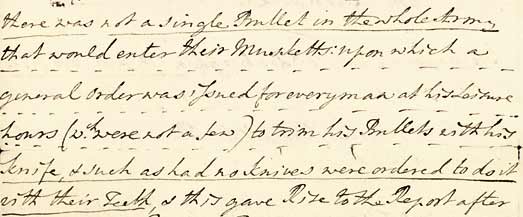The landing, and the reactions of the British government
In the spring of 1745, Prince Charles issued a number of posters urging men to join him when he landed in the British Isles. The poster shown in this Unit (Document 1) fell into the hands of the First Lord of the Treasury, Henry Pelham, the equivalent of a modern Prime Minister. All the documents shown in this Unit are from his papers, except Document 14, which is from the Galway manuscripts.
Soon after, Prince Charles set out for Scotland with only two ships. One of these ships, the Elizabeth, was carrying most of the money, ammunition and stores. Unfortunately the English ship Lion attacked her, and forced her back to France, but Prince Charles pressed on in the Doutelle and eventually landed on the Scottish mainland at Moidart. Here he met some Scottish chiefs, but he had very little to offer in the way of money, arms or men - so they advised him to go home again. When he said he was home (in his Scottish kingdom), they were no more enthusiastic. Against their advice, he decided to press on with his plan to invade England, even though he had had little training as a soldier.
To have any hope of succeeding, Charles needed the support of the important Highland chiefs, who could raise large numbers of their clansmen, who were hardy and fierce fighting men. One leading chief, Donald Cameron of Lochiel, decided to back Charles whose standard was raised at Glenfinnan on 19th August 1745. News of these events was beginning to reach Henry Pelham in London (Document 2).
Sufficient Highland clansmen joined Charles to allow him to press on. There was now in any case no turning back; the Doutelle had sailed for France on 9th August. Although there was a British Army under General Cope in Edinburgh, Charles marched south to Perth, where early in September he declared that his father was king of England and Scotland. A large number of clansmen had by now joined him, and he wrote to his father that all was going well (Document 3). By this time, Cope's army had moved north but was likely to return to Edinburgh if it did not intercept the Highlanders. Charles decided to make a dash for the city of Edinburgh - the capital of Scotland - to get there first.
During this march, a few of his men met a force of British cavalry, which fled after a few shots had been fired. This greatly encouraged Charles and his soldiers, and they marched boldly up to the gates of Edinburgh. Because there were no soldiers to protect the city, the Edinburgh Council panicked and surrendered except for the castle, which had a garrison and held out.
The British Government under Henry Pelham was very worried. They were receiving wild reports about what was happening (Document 4). A major problem was the quality of the troops in Scotland, and the fact that they were spread out. There were a number of troops at Fort Augustus, Fort William and Fort Bernera, but these were too few to attack the Highlanders. The leading Scots supporter of the British Government, the Duke of Argyll, was not even certain that the forts could defend themselves (Document 5). Further south there was a garrison of British soldiers at Stirling, but these were under Blakeney, who was an old and a sick man, as can be seen from his signature (Document 8).
The only British army in the field in Scotland was that commanded by General Cope. He had few men (about 1,400 foot soldiers and a small body of cavalry) and he was an inept commander who could never make up his mind. He kept sending Henry Pelham panic-stricken letters asking what he should do. When at last he decided to leave Edinburgh to go north, he weighed his army down with a huge amount of baggage (Document 6). This was just the beginning of Cope's mistakes. At Stirling he made his soldiers leave their swords behind so that they would not be mistaken for officers, who were not wearing their uniforms. (Normally these would have made the officers stand out). Then Cope discovered that he had forgotten the gunpowder; he therefore sent for muskets from the store at Stirling, along with gunpowder. (If he had just asked for gunpowder, it would have been obvious that he had forgotten it). Thus his men now had no swords, but extra and useless muskets.

Extract from 'Some Reflexions on General Cope's Behaviour in Scotland'
...there was not a single Bullet in the whole Army that would enter their Musketts: upon which a general Order was issued for everyman at his Leisure hours (w[hi]ch were not a few) to trim his Bullets with his knife, & such as had no knives were ordered to do it with their Teeth...
From Document 6
The next disaster was that Cope discovered he had brought the wrong sized bullets. These were too big to go down the barrels of his soldiers' muskets. He therefore ordered his men to cut or chew them down to size. (Later the Highlanders accused the British of using poisoned bullets because they made such terrible wounds).
Cope missed the Highland army, which had already captured Edinburgh. At this point he decided to send his army back to recapture Edinburgh, and so put his troops on board ships at Aberdeen.
Next page: Preston Pans and the invasion of England